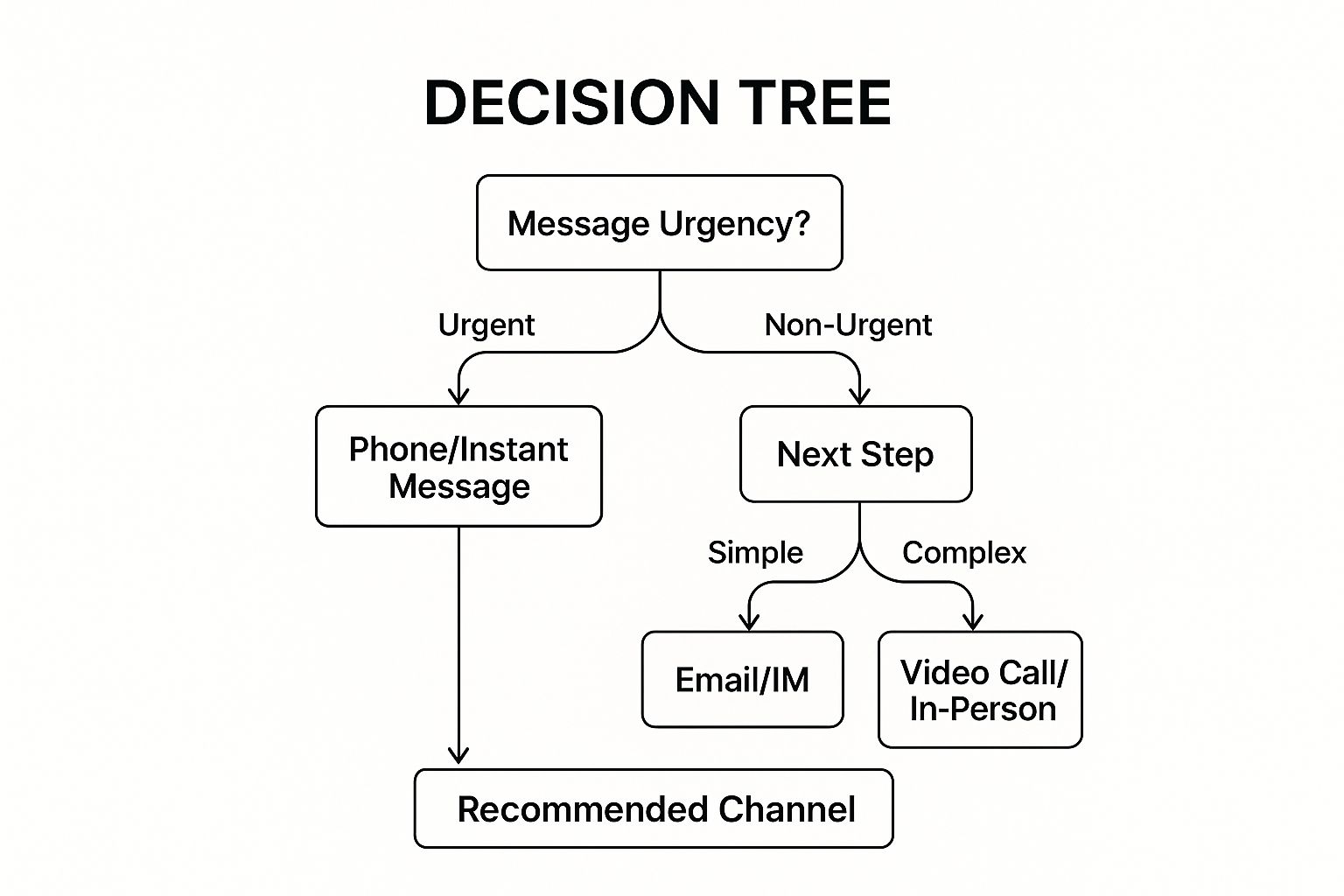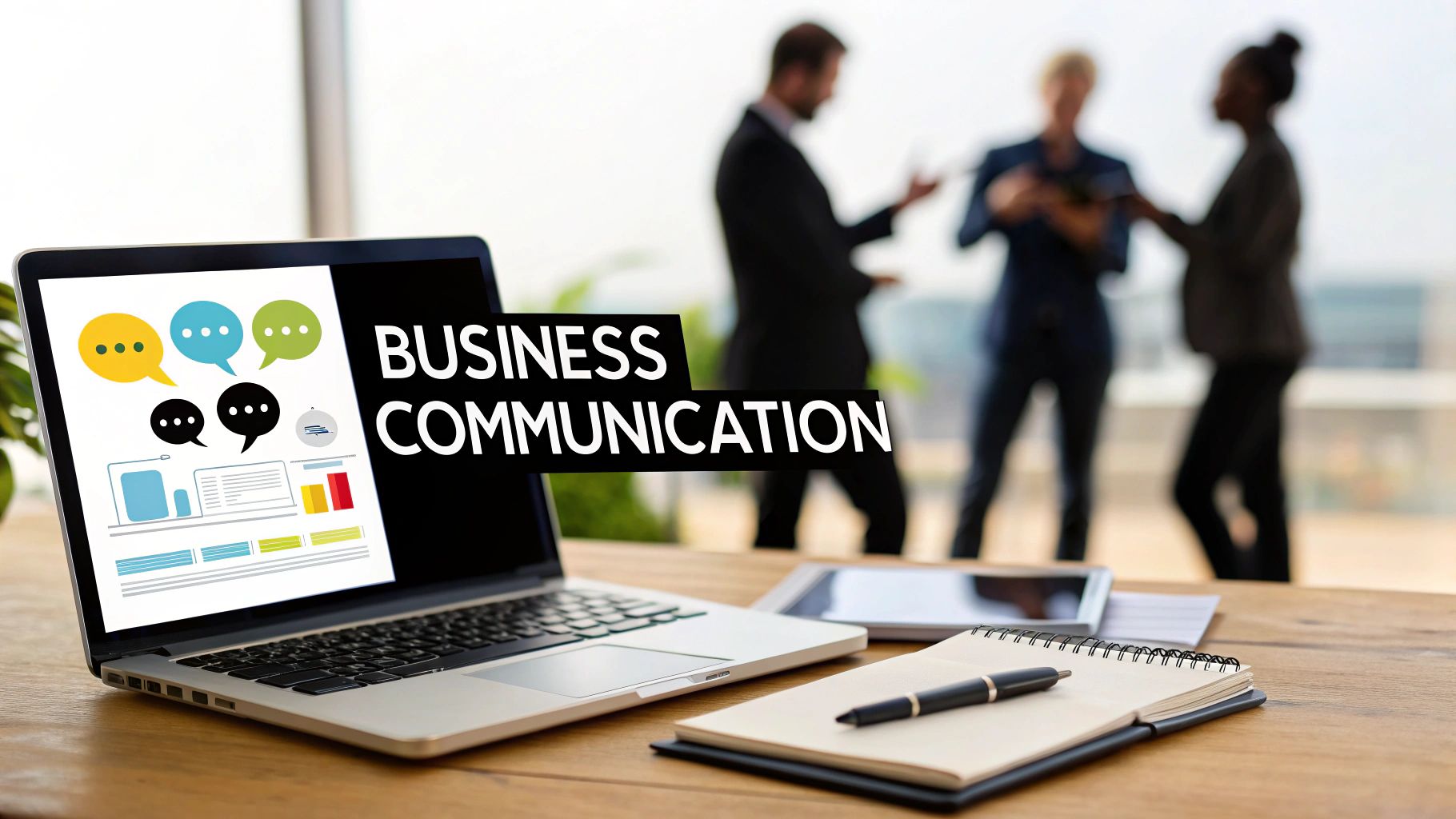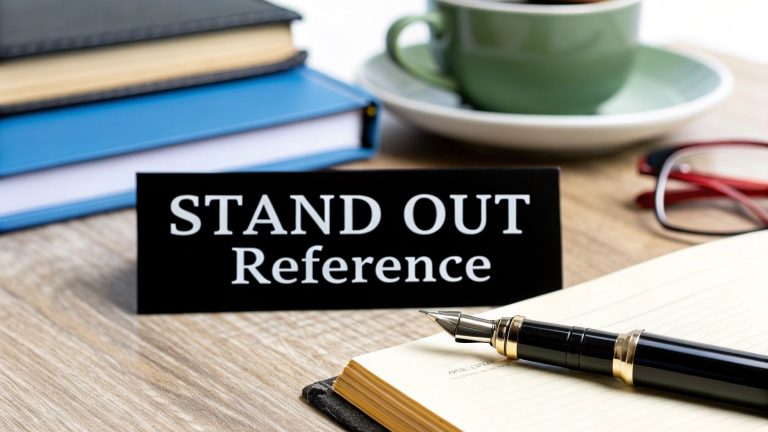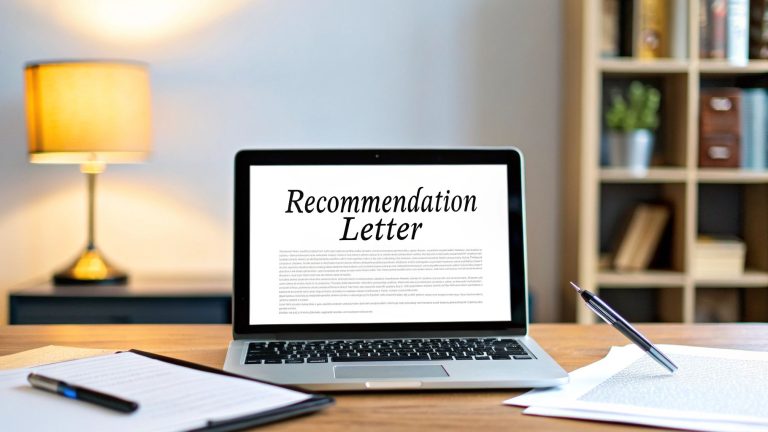In today's interconnected workplace, the ability to communicate effectively has transformed from a desirable 'soft skill' into a fundamental pillar of professional success. Misunderstandings, missed deadlines, and disengaged teams can often be traced directly back to a breakdown in how we share information. Poor communication doesn't just create friction; it erodes trust, stifles innovation, and directly impacts the bottom line. Thriving in any role, from team member to executive leader, now depends on mastering clear, intentional, and empathetic interaction.
This guide moves beyond generic advice to deliver actionable business communication best practices you can implement immediately. We will break down eight essential strategies that are critical for building stronger professional relationships and fostering a more efficient, collaborative environment. You will learn practical techniques for everything from active listening and providing constructive feedback to choosing the right channel for your message and ensuring your communication is inclusive. These are the skills that separate good professionals from great ones. Let’s explore the specific practices that will help you communicate with greater impact and clarity.
1. Active Listening
Effective business communication best practices begin not with speaking, but with listening. Active listening is the practice of fully concentrating on, understanding, and thoughtfully responding to what others are communicating. It moves beyond simply hearing words to engaging with the speaker's complete message, including their non-verbal cues. This foundational skill ensures messages are accurately received, demonstrates respect, and builds the trust necessary for strong professional relationships.

This approach is a cornerstone for many successful organizations. Microsoft, for instance, integrates active listening into its leadership training to cultivate more empathetic and effective managers. Similarly, IBM's design thinking workshops use active listening exercises to drive collaborative innovation.
How to Implement Active Listening
To integrate active listening into your daily interactions, focus on being present and engaged. This means minimizing distractions by putting away your phone and closing unnecessary tabs during conversations.
Consider using a structured method like the RASA technique, popularized by speaker Julian Treasure:
- Receive: Pay full attention to the speaker without interruption.
- Appreciate: Use small verbal or non-verbal cues like nodding or saying "I see" to show engagement.
- Summarize: Periodically rephrase the speaker's key points to confirm your understanding.
- Ask: Pose clarifying questions to explore the topic more deeply.
For virtual meetings where focus can be challenging, taking brief notes helps retain key details. To enhance active listening in these environments and ensure thorough documentation, explore effective tools for transcribing Zoom meetings.
2. Clear and Concise Messaging
In business, time is a finite resource, and clarity is paramount. Clear and concise messaging is the practice of conveying information directly and efficiently, removing unnecessary jargon, complexity, and fluff. This approach ensures your core message is understood quickly and accurately, preventing the misunderstandings and delays that often plague overly complex communication. It respects the audience's time and boosts the effectiveness of every interaction.

This principle is a cornerstone of effective business communication best practices in many leading organizations. Amazon famously replaced PowerPoint presentations with narrative-style "six-page memos" to force clear, structured thinking. Similarly, Google’s internal email guidelines advocate for brevity and clear subject lines, while the U.S. military's BLUF (Bottom Line Up Front) method places the most critical information at the very beginning of a message.
How to Implement Clear and Concise Messaging
To make your communication more powerful, adopt a mindset of "less is more." Focus on delivering value and getting straight to the point without sacrificing essential context.
Start by applying these proven techniques to your writing and speaking:
- Use the Inverted Pyramid: Present the most important information first, followed by supporting details. This ensures your audience gets the key takeaway even if they only read the beginning.
- Keep It Simple: Apply the KISS principle: Keep It Simple and Straightforward. Use plain language and avoid jargon or acronyms that your audience may not understand.
- Edit Ruthlessly: After drafting your message, review it specifically to remove words or sentences that do not add value. As the authors of The Elements of Style advised, "Omit needless words."
- Prefer the Active Voice: Write "Our team launched the project" instead of "The project was launched by our team." The active voice is more direct, engaging, and easier to understand.
3. Choosing the Right Communication Channel
Selecting the appropriate communication channel is a critical component of effective business communication best practices. This means strategically matching your message's purpose, complexity, and urgency with the most suitable medium, whether that’s an instant message, email, phone call, or in-person meeting. The right choice ensures your message is received as intended, while the wrong one can lead to misunderstandings, inefficiency, and wasted opportunities.
This decision-making process is a core strategy for highly efficient companies. For instance, GitLab’s comprehensive communication handbook specifies which channels to use for different scenarios to support its all-remote workforce. Similarly, companies like Shopify use Slack for quick, informal team collaboration while reserving email for more formal, documented correspondence, ensuring clarity and focus.
The following infographic illustrates a simple decision-making process to help you select the most effective channel.

This flowchart highlights how urgency and complexity are key factors in determining whether a synchronous or asynchronous channel is best.
How to Choose the Right Channel
To consistently select the best medium, start by assessing your message and audience. Use a mental framework like the "richness ladder," where face-to-face or video calls are "richer" and best for complex or sensitive topics, while email or instant messages are "leaner" and suited for simple information delivery.
Consider these practical guidelines for channel selection:
- Urgent & Simple: Use instant messaging or a quick phone call for immediate answers that don't require much context.
- Non-Urgent & Documented: Email is ideal for sending information that needs a record, involves multiple recipients, or doesn't require an instant response.
- Complex or Sensitive: Opt for a video call or in-person meeting to convey nuance, read non-verbal cues, and foster dialogue.
- Formal Outreach: For structured, formal communications like job inquiries, it's often best to follow established protocols, which you can explore further when drafting a letter of interest.
By consciously choosing your communication channel, you significantly improve the chances of your message being understood and acted upon correctly.
4. Emotional Intelligence in Communication
Emotional intelligence (EI) is the ability to recognize, understand, and manage your own emotions while also recognizing, understanding, and influencing the emotions of others. In the context of business communication best practices, it means navigating interpersonal dynamics with empathy and awareness. This skill is critical for building stronger relationships, resolving conflicts productively, and fostering a psychologically safe environment where team members feel valued and understood.
This approach has been a key driver of cultural transformation in major corporations. Satya Nadella, for example, famously shifted Microsoft's culture by championing empathy and EI. Similarly, Google's "Search Inside Yourself" program was developed to teach mindfulness and emotional intelligence to its employees, improving well-being and leadership.
How to Implement Emotional Intelligence
Integrating emotional intelligence into your communication requires conscious effort and self-reflection. Start by paying closer attention to your own emotional state and how it impacts your interactions. This self-awareness is the foundation upon which all other EI skills are built.
To develop this practice, focus on these actionable strategies:
- Pause Before Responding: In emotionally charged situations, take a moment to breathe and think before you speak. This prevents impulsive reactions.
- Use 'I' Statements: Frame feedback and express feelings from your perspective to avoid placing blame. For instance, say "I feel concerned when deadlines are missed" instead of "You always miss deadlines."
- Validate Others' Feelings: Acknowledge the other person's emotions, even if you don't agree with their viewpoint. A simple "I can see why you feel that way" can de-escalate tension.
- Seek Feedback: Ask trusted colleagues how your communication style affects them. This provides valuable insight into how your emotional expressions are perceived.
Developing emotional intelligence is particularly vital when conveying empathy during difficult times. To learn how to apply these principles effectively, you can explore guides on how to write a condolence letter.
5. Providing and Receiving Constructive Feedback
Effective business communication best practices must include the skill of sharing specific, actionable observations to promote growth. Constructive feedback is this two-way process of both giving and receiving information about performance in a way that encourages improvement rather than defensiveness. Mastering this skill drives continuous development, strengthens team performance, and fosters a culture of trust and transparency.
This practice is central to high-performing companies. Netflix is famous for its culture of "radical candor," encouraging direct feedback at all levels. Similarly, Adobe replaced annual reviews with its "Check-In" system, which facilitates ongoing feedback conversations. Bridgewater Associates, under Ray Dalio, institutionalized this with "Radical Transparency," using real-time feedback tools to maintain high standards.
How to Implement Constructive Feedback
To effectively provide feedback, structure your message to be clear, objective, and forward-looking. This helps the recipient understand the issue without feeling personally attacked, making them more receptive to your suggestions.
Consider using the SBI (Situation-Behavior-Impact) model for clarity:
- Situation: Describe the specific context. ("During the team meeting yesterday…")
- Behavior: Detail the observable action. ("…when you presented the quarterly data…")
- Impact: Explain the effect of that behavior. ("…it was unclear how you reached your conclusions, which created confusion.")
When on the receiving end, listen without immediately defending yourself. Ask clarifying questions to fully understand the feedback, thank the person for sharing it, and take time to reflect on the points. Regular, informal feedback is often more effective than saving it for formal reviews. When a formal approach is necessary for a complaint, knowing how to write a complaint letter can ensure your feedback is documented clearly and professionally.
6. Cultural Sensitivity and Inclusive Communication
In an increasingly globalized and diverse workplace, one of the most critical business communication best practices is cultural sensitivity. This involves recognizing, respecting, and adapting to cultural differences in communication styles, values, and expectations. Inclusive communication takes this a step further, ensuring every stakeholder feels valued and able to contribute fully, regardless of their background, identity, or ability. This competency is essential for effective collaboration, innovation, and global market success.
This approach is championed by leading global companies. For instance, Accenture's 'Truly Human' initiative fosters inclusive communication among its vast workforce. Similarly, Salesforce empowers employees through its Equality Groups, which provide cultural competence training to enhance business interactions. These examples show how prioritizing inclusivity builds stronger, more effective teams.
How to Implement Inclusive Communication
To practice cultural sensitivity, you must actively learn and adapt. Start by educating yourself on different cultural norms, particularly regarding directness, context, and non-verbal cues. This awareness helps prevent misunderstandings and builds stronger international and cross-functional relationships.
Consider these actionable strategies, inspired by the work of experts like Erin Meyer, author of The Culture Map:
- Avoid Idioms: Steer clear of slang, jargon, and cultural references that may not translate well or could cause confusion for a global audience.
- Use Inclusive Language: Opt for gender-neutral terms like "folks" or "team" instead of "guys," and use singular "they/them" pronouns.
- Be Aware of Context: Recognize the difference between high-context cultures (where communication is indirect and relies on shared understanding) and low-context cultures (where messages are explicit and direct).
- Ask, Don't Assume: Approach differences with genuine curiosity. Asking clarifying questions is always better than making assumptions about someone's background or perspective.
- Acknowledge Mistakes: If you make a cultural misstep, acknowledge it, apologize sincerely, and learn from the experience.
7. Transparency and Authenticity
Building trust is a core objective of effective business communication best practices, and it is achieved through transparency and authenticity. Transparency involves openly sharing relevant information, from organizational decisions to challenges and mistakes. Authenticity is about communicating genuinely, in a way that aligns with your personal and company values, rather than projecting a polished but false corporate image. Together, they create an environment of psychological safety and credibility.
This approach has been famously championed by companies like Buffer, which practices "radical transparency" by publicly sharing detailed revenue data and employee salaries. Similarly, when Airbnb faced layoffs during the COVID-19 pandemic, CEO Brian Chesky’s transparent and empathetic letter to employees was widely praised for its authenticity and respect, reinforcing trust even during a crisis.
How to Implement Transparency and Authenticity
To integrate these principles, focus on honest and open dialogue, especially when the news is difficult. Avoiding sugar-coating bad news builds long-term credibility that outweighs any short-term discomfort.
Consider these actionable strategies:
- Explain the 'Why': When communicating decisions, especially unpopular ones, clearly explain the reasoning behind them. This helps stakeholders understand the context and feel respected.
- Admit Imperfection: Be comfortable saying, "I don't have the answer yet." Admitting uncertainty is more authentic than pretending to have all the solutions and strengthens trust.
- Use Your Real Voice: Avoid excessive corporate jargon. Communicate in a clear, human way that reflects your personality and the company’s values.
- Be Consistent: Ensure your message is consistent across all platforms and audiences. Contradictory communication quickly erodes trust and makes your efforts seem inauthentic.
To learn more about fostering this culture in leadership, explore the research of Brené Brown, whose work on vulnerability is foundational to authentic communication.
8. Professional Written Communication Standards
In a digital age where written messages create permanent records and represent your brand, upholding high standards is crucial. Professional written communication involves mastering grammar, tone, and structure across emails, reports, and instant messages. It ensures clarity, projects competence, and prevents the misinterpretations that can damage relationships and derail projects. This practice is a cornerstone of effective business communication best practices, as it forms the basis of how an organization is perceived externally and operates internally.
This principle is rigorously applied by leading organizations. Amazon famously replaced PowerPoint presentations with six-page narrative memos for strategic proposals, forcing teams to crystallize their thinking through clear, structured writing. Similarly, consulting firm McKinsey & Company uses the SCQA (Situation-Complication-Question-Answer) framework to structure its written analysis, ensuring every report is logical and persuasive.
How to Implement Professional Written Communication Standards
To elevate your writing, focus on clarity, conciseness, and professionalism in every message. This means being deliberate about how you structure and review your communications before hitting send.
Start by adopting a clear structure for your documents and emails:
- Use descriptive subject lines: Clearly state the content and urgency (e.g., "Urgent: Feedback Needed on Q3 Report Draft by EOD").
- Front-load key information: Place the most critical message or call-to-action in the first paragraph.
- Break up text: Use subheadings, bullet points, and short paragraphs to make your content scannable and easy to digest.
- Include a clear call to action: Explicitly state what you need the reader to do next.
Before finalizing any document, proofread it multiple times, ideally after taking a short break. For those looking to refine their skills in formal correspondence, exploring resources on professional letter writing can provide valuable templates and guidance.
Best Practices Comparison of 8 Communication Strategies
| Communication Practice | Implementation Complexity | Resource Requirements | Expected Outcomes | Ideal Use Cases | Key Advantages |
|---|---|---|---|---|---|
| Active Listening | Moderate; requires consistent practice | Time, mental focus, training | Reduced misunderstandings, stronger relationships, better problem-solving | One-on-one meetings, leadership, customer service | Builds trust, improves engagement, enhances understanding |
| Clear and Concise Messaging | Low to Moderate; requires editing skills | Time for drafting and revision | Increased comprehension, faster decisions, less confusion | Emails, reports, presentations, memos | Saves time, improves credibility, enhances retention |
| Choosing the Right Communication Channel | Moderate; requires understanding of platforms | Knowledge of tools, training | Improved message clarity, effectiveness, and responsiveness | Team coordination, urgent vs. non-urgent messaging | Reduces communication overload, respects preferences |
| Emotional Intelligence in Communication | High; ongoing self-awareness and skill development | Training, reflection, practice | Better conflict resolution, stronger teams, enhanced leadership | Leadership, conflict management, customer relations | Builds empathy, enhances influence, reduces stress |
| Providing and Receiving Constructive Feedback | Moderate to High; requires skill and trust | Training, time for dialogue | Accelerated growth, improved performance, stronger trust | Performance reviews, team development | Supports growth, transparency, continuous improvement |
| Cultural Sensitivity and Inclusive Communication | High; requires continuous learning | Education, cultural competence training | Enhanced collaboration, reduced offense, diverse talent retention | Global teams, diverse workplaces | Prevents misunderstandings, drives innovation, inclusion |
| Transparency and Authenticity | Moderate; requires courage and discernment | Leadership commitment, communication channels | Higher trust, engagement, better crisis management | Leadership communication, organizational change | Builds credibility, psychological safety, loyalty |
| Professional Written Communication Standards | Moderate; requires writing skills and standards | Time, writing tools, training | Clear, professional documents, reduced errors, lasting records | Business emails, reports, proposals | Enhances professionalism, reduces miscommunication |
Putting It All Together: Your Communication Toolkit
The journey to becoming a masterful communicator is ongoing, built not on a single grand gesture, but on the consistent application of small, intentional habits. We've explored a wide range of business communication best practices, from the foundational power of active listening to the nuanced art of providing constructive feedback. Each principle, whether it's ensuring your messages are clear and concise or adapting your approach with cultural sensitivity, serves as a vital tool in your professional toolkit.
Think of these strategies not as a rigid checklist but as a flexible framework. You don’t need to overhaul your entire communication style overnight. The most effective approach is to start small. Choose one or two areas that resonate most with your current challenges. Perhaps this week, your focus is on being more mindful of non-verbal cues in video calls. Next week, you might concentrate on applying stricter professional standards to your written communication, double-checking every email for tone and clarity.
Building Your Action Plan
Transforming knowledge into skill requires deliberate practice. To start implementing these concepts today, consider these actionable steps:
- Self-Audit: Take a day to consciously observe your communication patterns. Where do you excel? Where do you feel you could improve? Maybe you notice you interrupt others in meetings or that your emails are often longer than necessary. Awareness is the first step toward improvement.
- Set a Micro-Goal: Choose one specific, measurable goal for the next week. For example, "I will paraphrase the other person's key points in at least two conversations each day to confirm my understanding" or "I will run every client-facing email through a grammar checker before hitting send."
- Seek Feedback: Ask a trusted colleague or mentor for their observations. You could ask, "In our last project meeting, was my feedback on the proposal clear and helpful?" This direct approach not only provides valuable insight but also models the very transparency we’ve discussed.
The Lasting Impact of Effective Communication
Mastering these business communication best practices does more than just prevent misunderstandings. It builds trust, fosters stronger professional relationships, and creates a more inclusive and productive work environment. When teams communicate effectively, collaboration thrives, innovation accelerates, and conflicts are resolved constructively. By investing in these skills, you are investing directly in your career growth and the success of your organization. For a comprehensive resource on cultivating and enhancing your overall business communication skills, explore these essential business communication skills to further deepen your expertise.
Ultimately, great communication is a commitment. It's about showing respect for others' time and perspective, striving for clarity over complexity, and building bridges through authentic connection. Keep these tools sharp, use them often, and you’ll be well-equipped to navigate any professional landscape with confidence and impact.
Struggling to find the right words for a crucial email or formal letter? Let the AI Letter Generator help you apply these best practices instantly. Create polished, professional, and effective correspondence in seconds by visiting the AI Letter Generator and transform your ideas into impactful messages.






